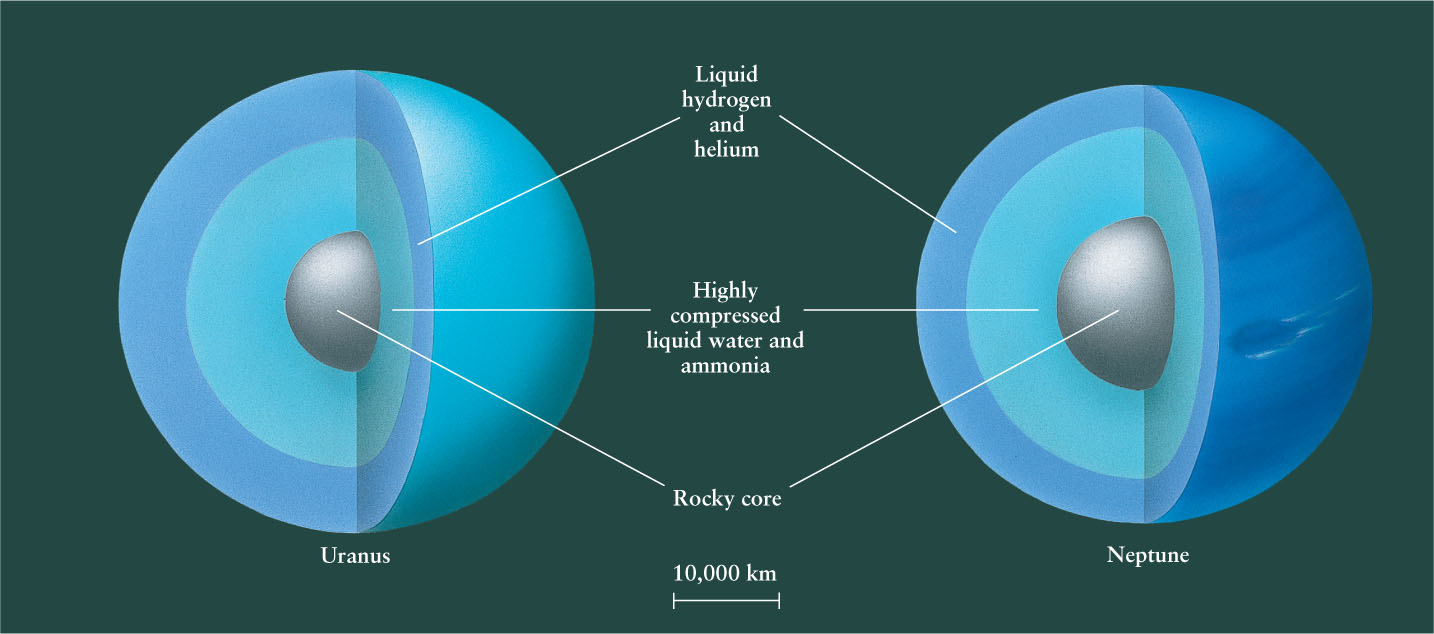14-4 Uranus and Neptune contain a higher proportion of heavy elements than Jupiter and Saturn
At first glance, Uranus and Neptune might seem to be simply smaller and less massive versions of Jupiter or Saturn (see Table 7-1). But like many first impressions, this one is misleading because it fails to take into account what lies beneath the surface. We saw in Section 14-2 that the interiors of both Jupiter and Saturn are composed primarily of hydrogen and helium, in nearly the same abundance as the Sun. But Uranus and Neptune must have a different composition, because their average densities are too high.
Uranus and Neptune: Curiously Dense
If Uranus and Neptune formed from gas with similar abundances of elements as Jupiter and Saturn, the smaller masses of Uranus and Neptune would produce less gravitational compression, and Uranus and Neptune would both have lower average densities than Jupiter or Saturn. In fact, however, Uranus and Neptune have average densities (1320 kg/m3 and 1640 kg/m3, respectively) that are comparable to or greater than those of Jupiter (1330 kg/m3) or Saturn (690 kg/m3). Therefore, we can conclude that Uranus and Neptune contain greater proportions of the heavier elements than do Jupiter or Saturn.
This picture is not what we might expect. According to our discussion in Section 8-5 of how the solar system formed, hydrogen and helium should be relatively more abundant as distance from the vaporizing heat of the Sun increases. But Uranus and Neptune contain a greater percentage of heavy elements and, therefore, a smaller percentage of hydrogen and helium, than Jupiter and Saturn.
A related problem is how to explain the masses of Uranus and Neptune. At the locations of Uranus (19 AU from the Sun) and Neptune (30 AU from the Sun) the solar nebula was probably so sparse that these planets would have taken thousands of millions of years to grow to their present sizes around a core of icy planetesimals. But protoplanetary disks observed around other stars (see Section 8-4) do not appear to survive for that long before they dissipate. In other words, the problem is not how to explain why Uranus and Neptune are smaller than Jupiter and Saturn; it is how to explain why Uranus and Neptune should exist at all!
Models of How Uranus and Neptune Formed
Explaining the origins of Uranus and Neptune poses a challenge to planetary scientists
In one model for the origin of Uranus and Neptune, the planets formed in denser regions of the solar nebula closer to the Sun (see the Nice model, Section 8-6). In this region they could have grown rapidly to their present sizes. Had the planets remained at these locations, they could eventually have accumulated enough hydrogen and helium to become as large as Jupiter or Saturn. But before that could happen, gravitational interactions with Jupiter, Saturn, and the disk of planetesimals would have deflected Uranus and Neptune outward into their present large orbits. Because the solar nebula was very sparse at those greater distances, Uranus and Neptune stopped growing and remained at the sizes we see today.
Figure 14-7 shows one model for the present-day internal structures of Uranus and Neptune. (Compare this to the internal structures of Jupiter and Saturn, shown in Figure 12-13.) In this model each planet has a rocky core roughly the size of Earth, although more massive. Each planet’s core is surrounded by a mantle of liquid water and ammonia. (This mixture means that the mantle is chemically similar to household window cleaning fluid.) Around the mantle is a layer of liquid molecular hydrogen and liquid helium, with a small percentage of liquid methane. This layer is relatively shallow compared to those on Jupiter and Saturn, and the pressure is not high enough to convert the liquid hydrogen into liquid metallic hydrogen.

CONCEPT CHECK 14-4
Why is it thought that Neptune had to form closer to the Sun than its present distance?
At Neptune’s present distance, there would not have been enough matter to form such a large planet. Furthermore, even if there were more matter, Neptune has a higher proportion of heavy elements than expected in the outer reaches of the solar system.